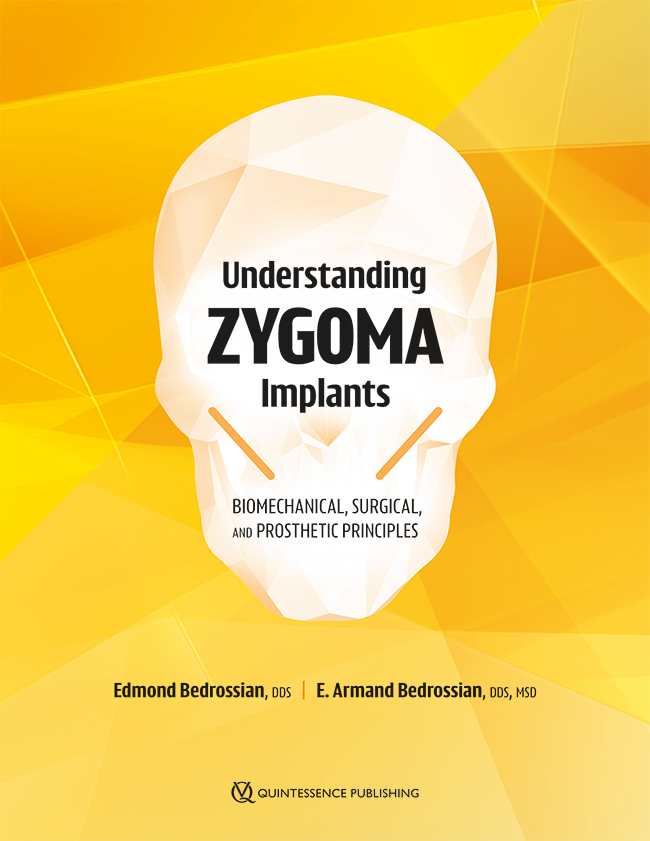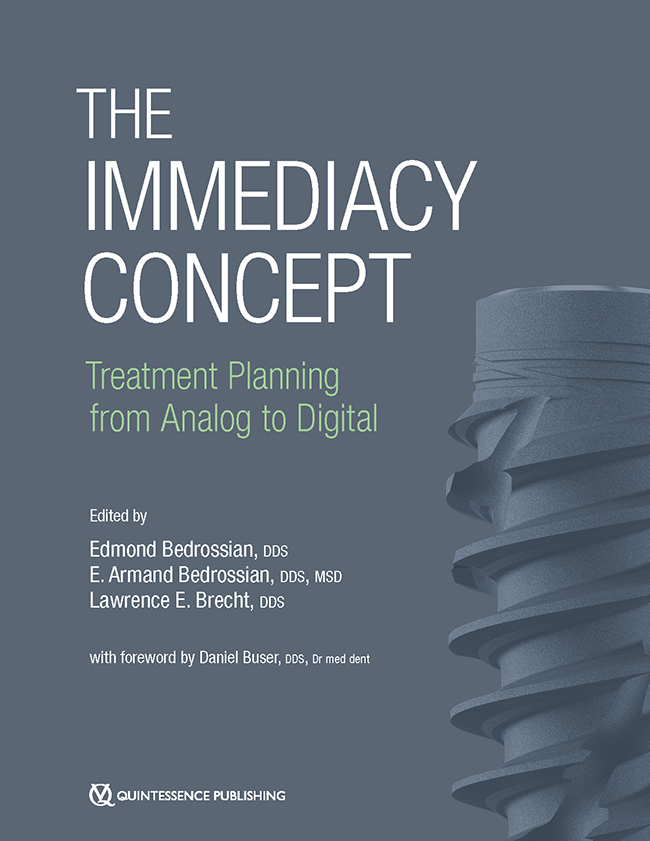The International Journal of Oral & Maxillofacial Implants, 5/2024
DOI: 10.11607/jomi.10683, ID de PubMed (PMID): 38607358Páginas 731-736, Idioma: InglésStumpel, Lambert J. / Bedrossian, Edmond A. / Revilla-León, MartaThe following technique describes the virtual planning of a single implant by combining an intraoral digital scan, an open-source computer-aided design software program, bone sounding, and 2D radiographic imaging. The surgical implant guide is fabricated using additive manufacturing technologies. Further, the surgical implant guide positioned in the patient’s mouth is used to radiographically verify the estimated mesiodistal implant angulation before proceeding with the surgical intervention and can be modified if necessary. When a CBCT scan is not available, this technique eases implant planning procedures and minimizes possible surgical complications.
Palabras clave: 3D printing, additive manufacturing, computer-aided design, computer-aided implant planning, surgical implant guide
The International Journal of Oral & Maxillofacial Implants, 3/2019
Sólo en líneaDOI: 10.11607/jomi.7196, ID de PubMed (PMID): 30716142Páginas e33-e41, Idioma: InglésBedrossian, Edmond / Bedrossian, E. ArmandPurpose: This review article evaluated biomechanical studies, finite element analyses, and clinical papers on the prosthetic and surgical principles for the survival of implants when reconstructing the edentulous mandible, including the use of a three-implant-supported fixed prosthesis.
Materials and Methods: A comprehensive search of studies published from 1983 to December 2017 listed in the PubMed/MEDLINE databases was performed. Relevant studies were selected according to predetermined inclusion and exclusion criteria.
Results: The initial database search yielded 942 titles. After filtering, 157 abstracts were selected, with 68 articles considered relevant and included. Consensus among authors was identified in regard to the number and the distribution of implants, limiting or eliminating distal cantilevers, and the principles of biomechanical loading of a cross-arch splinted prosthesis.
Conclusion: The result of this review suggests that reconstruction of the edentulous mandible with a fixed prosthesis using three, four, or six implants is a viable treatment option. However, when using three implants, wider-diameter implants are recommended for favorable force control.
Palabras clave: ad modum Brånemark, biomechanics, graftless solution, implant, mandible
The International Journal of Oral & Maxillofacial Implants, 5/2018
Sólo en líneaDOI: 10.11607/jomi.6539, ID de PubMed (PMID): 30231096Páginas e135-e145, Idioma: InglésBedrossian, Edmond / Bedrossian, E. ArmandPurpose: To review potential complications that may occur using the zygoma implant published in the literature as well as complications encountered by the primary author. Solutions for prevention as well as the management of such complications are also discussed in detail.
Materials and Methods: The authors have reviewed and outlined reports discussing the etiology as well as the management of potential complications associated with the use of the zygoma implant and have offered recommendations for the management of these complications.
Results: Predictable clinical solutions are offered for the identification of the cause as well as the management of complications, including orbital involvement, intracranial involvement, paresthesia of V2, subperiosteal infections, overextended apical extension, vestibular dehiscence, failed zygoma implant, fractured implant, and management of sinus infections.
Conclusion: A comprehensive knowledge of the specific steps for the proper execution of this complex procedure will allow for a predictable outcome as presented by the systematic reviews of the zygoma implant, which have reported a cumulative survival rate of 96.7% to 97.8%. Understanding the cause, the prevention, as well as the management of potential complications is imperative for the contemporary surgeon using the zygoma implant.
Palabras clave: ad modum Brånemark, biomechanics, complications, extra-sinus, implant, maxillary reconstruction, zygoma, zygomatic
International Journal of Oral Implantology, 5/2017
SuplementoID de PubMed (PMID): 28944370Páginas 79-87, Idioma: InglésTuminelli, Frank J. / Walter, Leora R. / Neugarten, Jay / Bedrossian, EdmondStatement of problem: Zygomatic implants have been utilised for the treatment of the severely atrophic maxilla since 1998. However, few articles exist as to the success of zygomatic implants and immediate loading of its prosthesis.
Aim: To systematically review the outcome of immediate loaded zygomatic implants.
Materials and methods: An electronic PubMed search was performed to identify case reports, prospective and retrospective studies of immediately loaded zygomatic implants with a mean follow-up of 12 months. Assessment of the identified studies was performed using the Delphi method. Reviewers independently assessed the articles for inclusion, with a facilitator coordinating responses. A consensus was reached on the articles that were included.
Results: The search provided 236 titles for immediately loaded zygomatic implants and resulted in 106 abstracts for analysis. Full-text analysis was performed on 67 articles, resulting in the inclusion of 38 articles for this systematic review.
Conclusion: Based on the present systematic review, the authors report that immediately loading zygomatic implants for the restoration of the severely atrophic maxilla presents a viable alternative for treatment of the atrophic maxilla.
Palabras clave: immediate load dental implant, zygoma, zygomatic implant
The International Journal of Oral & Maxillofacial Implants, 5/2017
DOI: 10.11607/jomi.5521, ID de PubMed (PMID): 28906505Páginas 1080-1085, Idioma: InglésAlzoubi, Fawaz / Bedrossian, Edmond / Wong, Allen / Ferrell, Douglas / Park, Chan / Indresano, ThomasPurpose: To assess outcomes of treating completely edentulous patients with a fixed implant-supported profile prosthesis, utilizing a graftless approach, for the maxilla and for the mandible, with an emphasis on patientrelated outcomes, specifically maximum occlusal force, patient satisfaction, and impact on quality of life.
Materials and Methods: This was a cross-sectional study with the following inclusion criteria: completely edentulous patients rehabilitated with a fixed implant-supported profile denture, utilizing a graftless approach. Patients fulfilling the inclusion criteria were asked to participate in the study during their follow-up visits; hence, a consecutive sampling strategy was used. To measure maximum occlusal force, a digital occlusal force gauge was used. Subjects were asked to answer a paper survey distributed in the clinic. The survey contained general demographic questions, visual analog scale (VAS) categories, and Oral Health Impact Profile-14 (OHIP-14).
Results: The mean VAS score was 8.9 out of a possible 10. The mean OHIP-14 score was 7.5 out of a possible 56. The mean maximum occlusal force recorded in the anterior region was 108 Ncm. The mean maximum occlusal force recorded in the posterior region was 205 Ncm.
Conclusion: Results indicated that patients treated with a graftless approach reported high satisfaction and impact on quality of life. Regarding maximum occlusal force values, significant differences between men and women were reported. The impact on quality of life seemed to improve when patients presented completely edentulous at the time of treatment as opposed to terminal dentition. Finally, significant positive correlations were detected between satisfaction and impact on quality of life, impact on quality of life and posterior maximum occlusal force, anterior and posterior maximum occlusal force, and complications and anterior maximum occlusal force.
Palabras clave: All-on-4, graftless, hybrid, impact on quality of life, maximum occlusal force, patient satisfaction, profile prosthesis, tilted implants, zygoma
The International Journal of Oral & Maxillofacial Implants, 4/2017
DOI: 10.11607/jomi.5519, ID de PubMed (PMID): 28708921Páginas 897-903, Idioma: InglésAlzoubi, Fawaz / Bedrossian, Edmond / Wong, Allen / Farrell, Douglas / Park, Chan / Indresano, ThomasPurpose: To assess outcomes of treating completely edentulous patients with a fixed implant-supported profile prosthesis utilizing a graftless approach for the maxilla and for the mandible, with emphasis on clinically related outcomes, specifically implant and prosthesis survival.
Materials and Methods: This was a retrospective study with the following inclusion criteria: completely edentulous patients rehabilitated with a fixed implant-supported profile denture utilizing a graftless approach. Patients fulfilling the inclusion criteria were asked to participate in the study during their follow-up visits, and hence a consecutive sampling strategy was used. Data regarding implant and prosthesis cumulative survival rates (CSRs) were gathered and calculated.
Results: Thirty-four patients were identified with a total of 220 implants placed. An overall CSR of 98.2% was recorded with an observation of up to 10 years. For tilted, axial, and zygomatic implants, CSRs of 96.9%, 98.0%, and 100%, respectively, were observed for up to 10 years. For provisional prostheses, CSRs of 92.3% at 1 year, and 84.6% at 2 years were observed.
Conclusion: The results suggest that treating completely edentulous patients with a fixed profile prosthesis utilizing a graftless approach in the maxilla and the mandible can be a reliable treatment option.
Palabras clave: All-On-4, fixed prosthesis, graftless, immediate loading, tilted implants, zygoma implants
The International Journal of Oral & Maxillofacial Implants, 6/2010
ID de PubMed (PMID): 21197500Páginas 1213-1221, Idioma: InglésBedrossian, EdmondPurpose: The success of zygomatic implants following the two-stage, as well as the immediate loading, concept has been well documented. This graftless approach for the treatment of the completely edentulous resorbed maxilla allows for rehabilitation with an implant-supported fixed prosthesis. The purpose of this prospective study is to report on the 7-year follow-up of patients treated with zygomatic implants in conjunction with two to four anterior maxillary implants placed into immediate function and restored with a definitive fixed prosthesis.
Materials and Methods: This prospective study involved 36 patients treated with 74 zygomatic implants and 98 anterior maxillary implants supporting fixed prostheses between 2003 and 2005.
Results: Two zygomatic implants in two patients were identified as mobile at stage-two surgery; replacement implants resulted in successful osseointegration. All anterior maxillary implants were determined as osseointegrated at stage two. Three patients experienced unilateral maxillary sinus infections that were refractory to oral antibiotics and were treated with functional endoscopic sinus surgery, which resolved the infections. All patients treated with the immediate loading concept were restored with definitive fixed profile prostheses as planned.
Conclusion: The high survival rate, reduced morbidity, and high rate of patient acceptance for the zygomatic implant concept allowed the rehabilitation of the resorbed edentulous maxilla with fixed implant-supported prosthesis, rendering this procedure a viable and a predictable treatment option.
Palabras clave: atrophied maxilla, edentulous maxilla, fixed maxillary prosthesis, immediate load, zygoma
The International Journal of Oral & Maxillofacial Implants, 6/2006
ID de PubMed (PMID): 17190304Páginas 937-942, Idioma: InglésBedrossian, Edmond / Rangert, Bo / Stumpel, Lambert / Indresano, ThomasPurpose: In many edentulous maxillae, posterior alveolar atrophy calls for bone grafting. Patient treatment acceptance is increased by eliminating grafting using tilted implants, especially the zygomatic implant in combination with immediate function. The purpose of this study was to evaluate a protocol for immediate function (within 2 hours) of 2 zygomatic and 4 standard implants (Nobel Biocare) supporting a fixed prosthesis in the completely edentulous maxilla.
Materials and Methods: This clinical study included 14 patients with 83 immediately loaded implants (28 bilateral zygomatic and 55 premaxillary implants) supporting a complete maxillary denture converted to a fixed provisional prosthesis immediately following the surgical procedure. After 6 months of use, a new fixed metal-supported prosthesis was fabricated.
Results: Fourteen patients treated with immediate loading of zygomatic implants were followed for at least 12 months. All patients reported minimization of postoperative pain and security during speech, animation, and mastication. No failures occurred during the follow-up period.
Discussion: The patients in the study could have been candidates for sinus grafting. With the present concept these patients benefited from a less invasive procedure (1 surgical procedure and no grafting) and immediate rehabilitation (prosthesis attached directly after surgery).
Conclusion: The high survival rate, increase in patients' immediate functional ability, and reduction of morbidity following the surgical procedure render this procedure a viable treatment option for the completely edentulous maxilla. (Case Series)
International Journal of Periodontics & Restorative Dentistry, 3/2003
Páginas 211, Idioma: InglésBedrossian, EdmondThe International Journal of Oral & Maxillofacial Implants, 6/2002
Páginas 861-865, Idioma: InglésBedrossian, Edmond / Stumpel III, Lambert / Beckely, Michael / Indresano, ThomasThe Brånemark Zygomaticus implant was used in conjunction with premaxillary standard implants for the reconstruction of resorbed edentulous maxillae. A total of 44 zygomatic implants and 80 premaxillary implants were placed in 22 patients. All implants were stabilized at phase II surgery using a rigid bar. After soft tissues had healed, implant-supported fixed prostheses were fabricated. This article presents a preliminary report on 22 patients followed for 34 months, with a 100% success rate for the zygomatic implants and a 91.25% success rate for the premaxillary implants.






